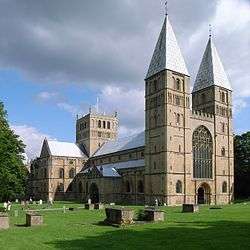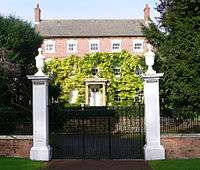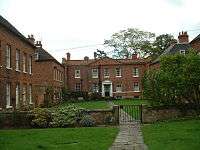Southwell, Nottinghamshire
| Southwell | |
|---|---|
 Southwell Minster | |
 Southwell Southwell shown within Nottinghamshire | |
| Population | 7,297 (2011) |
| OS grid reference | SK 70087 54093 |
| District | |
| Shire county | |
| Region | |
| Country | England |
| Sovereign state | United Kingdom |
| Post town | Southwell |
| Postcode district | NG25 |
| Dialling code | 01636 |
| Police | Nottinghamshire |
| Fire | Nottinghamshire |
| Ambulance | East Midlands |
| EU Parliament | East Midlands |
| UK Parliament | |
Southwell (/ˈsaʊθwɛl,
Early history
The remains of a large, opulent Roman villa were excavated beneath the minster and its churchyard in 1959.[5] Part of a mural from the excavation is displayed in the minster. The villa is one of three examples of its type found in the territories of the Corieltauvi (or Coritani) tribes – along with Scampton in Lincolnshire and Norfolk Street in Leicestershire. A section of the Fosse Way runs on the opposite bank of the River Trent with evidence of a Roman settlement at Ad Pontem ("to the bridge" or "at the bridge"), northwest of the village of East Stoke. There is no specific evidence of a road link between Ad Pontem and Southwell. Other evidence of a Roman settlement includes the use of Roman bricks in the prebendary buildings around the minster, remains of a fosse or ditch was discovered at Burgage Hill in the 19th century and it is speculated there may be Roman remains beneath the Church Street site of the recently vacated Minster School.
The Venerable Bede records the baptism of numerous converts in the "flood of the Trent" near Tiovulginacester by Paulinus in the presence of Edwin of Northumbria whom he had converted to Christianity in 627. There is no agreement on the exact location of Tiovulginacester, but Paulinus certainly visited the locale, and possiblly founded the first church in Southwell.
The remains of Eadburh, Abbess of Repton and daughter of Ealdwulf of East Anglia were buried in Southwell's Saxon church.[6] Eadburh was appointed Abbess under the patronage of King Wulfhere of Mercia. She appears in the Life of Guthlac and is believed to have died around AD 700. Her remains were buried or translated to Southwell Minster, where her relics were revered in the Middle Ages. The only reference is in a Pilgrims Guide to Shrines and Burial Places of the Saints of England, supposedly written in 1000, which records: "There resteth St. Eadburh in the Minster of Southwell near the water called the Trent."
Eadwy of England gifted land in Southwell to Oskytel the Archbishop of York, in 956. Eadwy's charter is the first dated reference to Southwell. Evidence of a tessellated floor and the 11th century tympanum over a doorway in the north transept are evidence of construction of the Minster after this time. The Domesday Book of 1086 has much detail of an Archbishop's manor in Southwell.
A custom known as the "Gate to Southwell" originated after 1109 when the Archbishop of York, Thomas I wrote to every parish in Nottinghamshire asking for contributions to the construction of a new mother church. Annually at Whitsuntide, contributions known as the "Southwell Pence" were taken to the minster in a procession that set off from Nottingham, headed by the mayor followed by clergy and lay people making a pilgrimage to Southwell's Whitsun Fair. The Southwell Pence were paid at the north porch of the minster to the Chapter Clerk. The "gate" in the name of the Southwell Gate means "street", as it does in many East Midland and North-Eastern street names, after the Norse word "gata". The custom in its original form persisted well into the 16th century. It was revived in 1981 by the Dolphin Morrismen.
Geoffrey Plantagenet was ordained as a priest at Southwell in 1189. On 4 April 1194, Richard I and the King of Scots, William I, was in Southwell, having spent Palm Sunday in Clipstone. King John visited Southwell between 1207 and 1213, ostensibly for the hunting in Sherwood Forest, but also en route in an expedition to Wales in 1212.
From 1300 to 1800
The Saracen's Head was built in 1463 on land gifted in 1396 by the Archbishop of York, Thomas Arundel, to John and Margaret Fysher. When built, the first floor overhung the roadway in the vernacular of the time.
In 1603, James VI of Scotland passed through Southwell on his way to London to be crowned King James I.[7]
During the English Civil War, King Charles I spent his last night as a free man in May 1646 in the Saracen's Head (then the King's Head), before surrendering to the Scottish Army stationed at nearby Kelham. The fabric of the town, the minster and Archbishop's Palace suffered at the hands of Oliver Cromwell's troops, as they sequestered the palace as stabling for their horses, broke down monuments, and ransacked the graves for lead and other valuables. In 1793, iron rings fastened to the walls to secure the horses were still in situ. The end of the civil war left the Archbishop's Palace in ruins apart from its Great Hall. It is reputed that Cromwell also stayed in the King's Head.
In 1656, a Bridewell was built on the Burgage. It was enlarged in 1787 when it became a prison for the county. There is evidence that a house of correction was built in 1611, so the Bridewell may itself have been an enlargement. Mary Ann Brailsford was baptized at Southwell in May 1791, and Matthew Bramley in 1796 in Balderton.
19th century and later
By 1801, the population was 2,305. In 1803, Lord Byron stayed with his mother in Burgage Manor during his holidays from Harrow and Cambridge. His mother rented the house; although by that time he had become 6th Baron Byron of Rochdale, the family home, Newstead Abbey required significant remedial work, which they could not afford.
Southwell today
As the site of an Anglican cathedral, the town is sometimes considered to be a city, and was treated as such in the 1911 Encyclopædia Britannica. However, its city status is not recognised by the government. Southwell has an active Town Council.[8]
The town is something of an oddity for north Nottinghamshire, being visibly affluent, when compared with its near neighbours of Newark-on-Trent and Mansfield. Whereas agriculture and coal respectively have seen the fortunes of the other two towns fluctuate over the years, Southwell has remained an area of residence for many of Nottingham's wealthiest residents.[9][10] It was featured in The Sunday Times shortlist of 'Best Places to Live 2017' for the Midlands region.[11]
In most parts of Nottinghamshire, 'Southwell' is pronounced SUH-thull, with a voiced 'th' (as in 'the' or 'there') and a silent 'w'. Residents of Southwell itself tend to pronounce the name as it is spelt.
The Town Council, following the 2015 elections, is composed of eight Liberal Democrat Councillors, six Conservatives and one Independent. The Chairman of the Council in 2015-6 is Beryl Prentice and the Chairman of Finance and Policy is Peter Harris.[12]
There are two infant schools (aged 3–5): Southwell Holy Trinity C of E Infants School and Lowes Wong Infant School.[13] The latter teaches local children aged 7–11. The local secondary school Southwell Minster School [14] also offers an education for the choristers of the cathedral and gifted musicians in its Junior Department. It has obtained particularly good GCSE and AS/A level results in Nottinghamshire.[15] The school supplies the Minster choir. Until recently, there was boarding accommodation for choirboys in the town.

It was here that the well-known Bramley cooking apple was first seeded by Mary Ann Brailsford in 1809.[16] A local nurseryman Henry Merryweather,[17][18] 17 years old, saw its potential and cultivated it from cuttings. The apple is now used across the cookery world, and is renowned for its acidic taste and the fact that it cooks to a smooth puree. One of the local football clubs, Southwell City, is nicknamed "The Bramleys", and the town's new library and youth centre is known as 'The Bramley Centre' in honour of the town's contribution to British cuisine. In March 2009, a stained glass window was installed in Southwell Minister, commemorating the Bramley apple's 200th anniversary.[19]
The local community newspaper is The Bramley, 11,200 copies are delivered monthly to Southwell and surrounding areas.
Sports clubs include Southwell Rugby Club (known as the Redmen) who were formed in 1922-23. In the 2011-12 season the club won an historical Treble of RFU Midlands 4 (East) North League Champions, Nottinghamshire Junior Cup winners and Nottinghamshire/Lincolnshire/Derbyshire Plate winners. Southwell Cricket Club and Southwell City Football Club, an FA Charter Standard Community Football Club involving over 400 local players in 35 teams aged five years to veteran.
Southwell has a leisure centre run by a local trust,[20] with trustees from the local community, although the district council also provides very limited support.
The town is accessed from Newark and Nottingham by the A612,and from north Nottingham and villages to the west by the B6386. The A617 primary route passes 2 miles to the north of the town in Hockerton, and the A1 and A46 trunk routes are both 7 miles away in Newark. The railway station at the nearby village of Fiskerton has had a small car park built in recent years to cater for Southwell commuters. Southwell is also served by Nottingham City Transport's rural Pathfinder 100 service[21] to Nottingham and Stagecoach East Midlands (Mansfield) service to Mansfield and Newark. There are other infrequent services to nearby villages.

The town is twinned with Sées, a small town in France, and with Český Brod in the Czech Republic.[22]
Notable people
In order of birth:
- St Edburga of Repton was translated from Repton Abbey to Southwell and died there about AD 700.
- Ælfric Puttoc (died 1051), Archbishop of York, died in Southwell.
- Geoffrey Plantagenet, natural son of King Henry II of England and Archbishop of York, was ordained priest in Southwell in 1181.
- Matthew Sylvester (c. 1636–1708), Nonconformist minister and religious writer, was born in Southwell.
- Thomas Spofforth (1743–1826), organist, died in Southwell.
- John Spray (c. 1768–1827), tenor singer and vicar choral for the Dublin cathedrals, was born in Southwell and sang as a child in the minster choir.
- Reginald Spofforth (1769–1827), composer and organist, was baptised in Southwell.
- Mary Anne Brailsford who grew the first Bramley cooking apple tree from seed, was baptised in Southwell in May 1791.
- Rev. John Thomas Becher (1770–1848), cleric, social reformer and friend of Lord Byron, was Vicar-General of Southwell Minster in 1818–40.
- Richard Ingleman (1777–1838), architect and surveyor, died in Southwell.
- Francis Tinley (1819–1889), first-class cricketer with Nottinghamshire, was born in Southwell, as was his first-class cricketing brother Vincent Tinley (1828–1899).
- Chappell Batchelor (1822–1884), organist and first-class cricketer, was born in Southwell and sang in the minster choir as a child.
- John Hatfield (1831–1889), first-class cricketer, was born in Southwell.
- William Horsley (1835–1864), first-class cricketer, was born and died in Southwell.
- Sebastian Smith (3 October 1869 – 15 January 1948) was a British stage and film actor. He was born in Southwell.
- Ted Hufton (1892–1967), international footballer, was born in Southwell.
- Sir Joseph Lockwood (1904–1991), whose company helped to finance The Beatles, was born in Southwell.
- Lilian Greenwood (born 1966), Labour MP for Nottingham South, moved to Southwell in 1999.
- Robert Edward Jenrick (born 1982), is an English Conservative Party politician who has served as the Member of Parliament (MP) for Newark since 2014, rents a property in Southwell.
- Scott Loach (born 1988), professional footballer, attended Southwell Minster School and played for Southwell United as a youth.
Transport links
Bus services
| Bus operator | Route number | Destination(s) | Notes |
|---|---|---|---|
| Nottingham City Transport | 100:Pathfinder | Nottingham - Carlton - Burton Joyce - Lowdham - Southwell | [23] |
| Stagecoach East Midlands | 28 | Mansfield - Rainworth - Southwell - Newark | [24] |
| 29 | Southwell - Newark | ||
| Travelwright | 3 | Lowdham - Southwell - Newark | [25] |
| 227 | Newark - Southwell - Bilsthorpe - Edwinstowe | Wednesday & Friday only. [26][27] | |
| Sherwood Countryman Buses | CM2 | Maplebeck - Eakring - Kirklington - Southwell | |
| Disused bus routes | |||
| Veolia Transport | D3 | Nottingham - Arnold - Lambley - Southwell - Newark | Service sold to Premiere[28] |
| Premiere | S9 | Southwell - Lowdham - Burton Joyce - Victoria Park | Premiere was liquidated on 25 January 2013[28] |
Railway station
Southwell had a passenger railway station from 1847 to 1959. Goods traffic continued until 1964.
Education
Secondary education in the town is predominantly provided by Southwell Minster School, which still educates choristers of Southwell Minster. The Minister School is a Specialist College for Humanities and Music and was rated 'outstanding' by OFSTED in 2011/12. Pupils may also choose to attend school at Newark-on-Trent about a 20-minute drive east. The School of Animal, Rural and Environmental Sciences is part of Nottingham Trent University and offers both further and higher education courses in agricultural-related subjects at its Brackenhurst campus just outside Southwell.
See also
- Dumble - a local word used to refer to a small wooded area.
- Hockerwood - a historic deer park in the area
- The Workhouse, Southwell — the former parish workhouse; the prototype for many around the country. Now a National Trust property.
References
- ↑ McCartney, David (24 August 2005). "South Well or Suthell?". Voices 2005. BBC Nottingham. Retrieved 5 March 2010.
- ↑ Wells, John C. (1990). Longman Pronunciation Dictionary. Harlow: Longman. ISBN 0-582-05383-8.
- ↑ "Town population 2011". Neighbourhood Statistics. Office for National Statistics. Retrieved 10 April 2016.
- ↑ Retrieved 16 November 2017.
- ↑ Daniels, C. M. "Excavations on the site of the Roman Villa in Southwell, 1959", Transactions of the Thoroton Society of Nottinghamshire, Vol. 70, 1966, pp. 13–33
- ↑ Rollason, D. W., "List of Saints' Resting Places in Anglo-Saxon England", Anglo-Saxon England 7, 1978, p. 89
- ↑ T. Bailey, Annals of Nottinghamshire: History of the County of Nottingham, including the Borough, Vol 2 (1853), p.544
- ↑ http://www.southwellcouncil.com/
- ↑ http://moneyobserver.com/news/28-10-2016/10-most-expensive-market-towns-revealed
- ↑ https://www.telegraph.co.uk/finance/property/house-prices/11258939/Fancy-living-in-an-English-market-town-Itll-cost-an-extra-25k.html
- ↑ https://www.thetimes.co.uk/article/sunday-times-best-places-to-live-2017-3qkwjnvrm#/region/midlands
- ↑ http://www.southwellcouncil.com
- ↑ http://www.loweswong-inf.notts.sch.uk/
- ↑ http://www.minster.notts.sch.uk/
- ↑ BBC News
- ↑ Martin, J (2004) "Brailsford, Mary Ann". In Oxford Dictionary of National Biography. Oxford, Oxford University Press, Vol 7 p. 289
- ↑ http://www.bramleyapples.co.uk/cooking_apples.html Archived 10 October 2010 at the Wayback Machine. bramleyapples.co.uk
- ↑ Merryweather, Roger, 1982, The Bramley: A World Famous Cooking Apple, Newark and Sherwood D.C., Nottinghamshire.
- ↑ http://www.newarkadvertiser.co.uk/template/temp1.asp?id=3d0cd852-65bb-102c-aaed-89f42bfb691d
- ↑ http://www.newark-sherwooddc.gov.uk/slc/
- ↑ https://www.nctx.co.uk/timetables-tickets-maps/buses-lines/bus/100
- ↑ "Archived copy". Archived from the original on 12 January 2005. Retrieved 14 February 2010.
- ↑ "Nottingham City Transport 'Pathfinder'". Retrieved 28 February 2013.
- ↑ "Nottinghamshire county Council - Bus Timetable". Retrieved 28 February 2013.
- ↑ "Nottinghamshire county Council - Bus Timetable". Archived from the original on 27 September 2011. Retrieved 28 February 2013.
- ↑ "Travelwrihgt Ltd". Archived from the original on 20 February 2013. Retrieved 28 February 2013.
- ↑ "Nottinghamshire county Council - Bus Timetable". Archived from the original on 21 November 2008. Retrieved 28 February 2013.
- 1 2 "BBC News". BBC News. Retrieved 2 March 2013.
Additional references
- Arundel, Betty M., "Southwell - A History Walk", The Southwell Civic Society, 2001
- Barry, F.R., "Period of my Life (Bishop of Southwell)", Hodder & Stoughton, 1970
- Beaumont, R.M. "A Flash of Lightning on Guy Fawkes Night, 1711: The Fire at Southwell Minster", The Thoroton Society, 1973
- Beaumont, R.M. "The Chapter of Southwell Minster, a Story of 1,000 years", Unknown Publisher, 1956
- Bishop, M., "An Archaeological Resource Assessment of Roman Nottinghamshire", EMARF, unknown date
- Boyes, M., "Love without wings: The story of the unique relationship between Elizabeth Bridget Pigot of Southwell and the young poet, Lord Byron", J.M. Tatler & Son, 1988
- Buckler, J. "The Collegiate Church of Saint Mary, Southwell", Bermondsey, 1810
- Clark, T.H. "The History and Antiquities of Southwell Collegiate Church", J. Whittingham, 1838
- Dobson, Roger, "Southwell Inns and Alehouses", Nottinghamshire County Council, 2008
External links
| Wikimedia Commons has media related to Southwell, Nottinghamshire. |